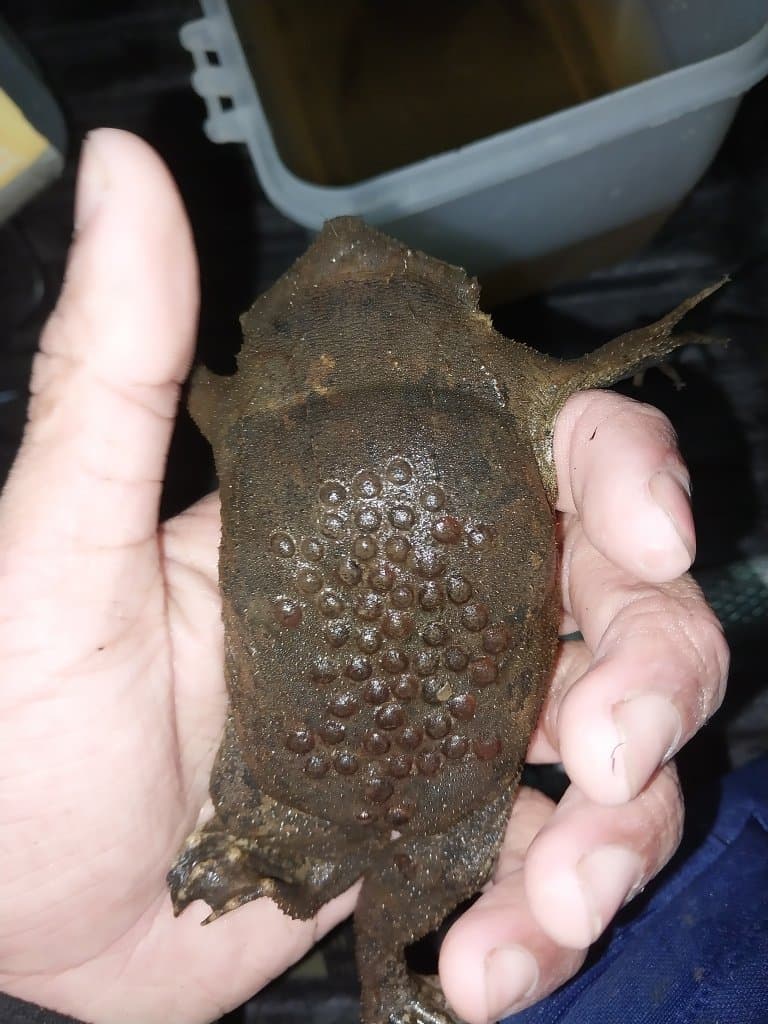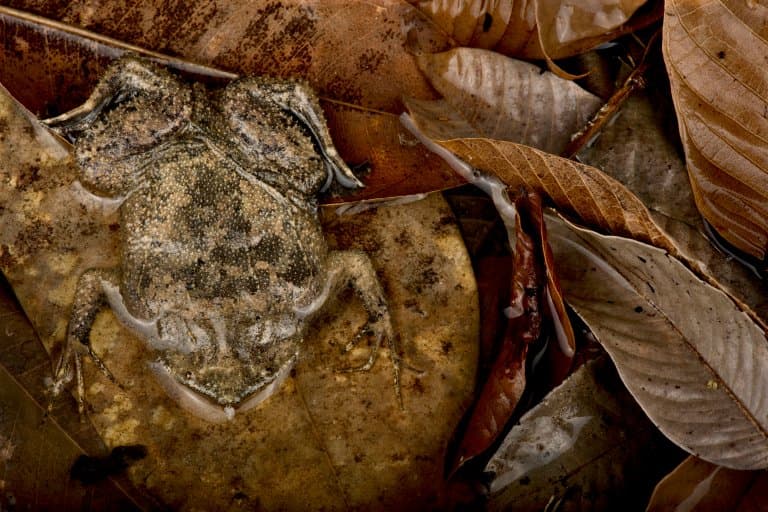Suriname Toad Profile
Trypophobia is the instinctive and overwhelming sense of disgust a person gets when they see certain things with lots of closely-packed holes in them.
Crumpets, seed pods, or horrific jigger infestations are all good examples of things that can trigger it, and if it’s something you struggle with, this is probably one you’ll want to sit out.
Suriname toads aren’t technically toads at all. They’re just ugly little frogs with a frightening reproductive strategy.

Suriname Toad Facts Overview
| Habitat: | Murky ponds and swamps |
| Location: | Panama and South America |
| Lifespan: | 7 years in captivity |
| Size: | Up to 20cm (8inches) |
| Weight: | About 160g (5.6oz) |
| Color: | Mottled brown |
| Diet: | Crustaceans, small fish, worms |
| Predators: | Larger fish, particularly as froglets |
| Top Speed: | Slow |
| No. of Species: |
7 |
| Conservation Status: |
|
Suriname toads are frogs of the genus Pipa, native to northern South America and southern Central America where they inhabit flooded forests, backwaters and streams.
There’s 7 species in total, with the common Surinam toad or star-fingered toad (Pipa pipa) the most widely distrubuted across South America.
They look like a submerged leaf, with beady little eyes and a toothless, tongueless grin. These frogs are ambush predators and will wait for prey to come into range before sucking insects, worms, and small fish into their mouths via suction feeding.
They spend most of their time entirely stationary, only moving to breathe once in a while or to mate, the latter of which results in a horrific infestation of subcutaneous froglets.
Interesting Suriname Toad Facts
1. They’re not toads!
This might come under the same semantic argument as whether a tomato is a fruit or a vegetable; ultimately, most people will differentiate a toad from a frog by how it’s used in the kitchen.
But there is a bit of taxonomy worth pointing out if you’re into that sort of thing.
All toads are frogs, under the order Anura, meaning “tail-less”. This includes all toads, who occupy a subdivision in the family Bufonidae. Famous examples of these are Bufo alvarius, the Sonoran Desert toad that secretes a milky substance designed to send Mexican shamans to another dimension.
But colloquially, toads are considered to be any frog that’s a bit more grotty-looking than the sleek and colourful frogs we’re more familiar with. In this instance, Pipa species are quite toad-like. 1
2. They’re exceptionally depressed
These are very flat frogs. They spend almost their entire lives in the water, only leaving in cases of emergency, and otherwise laying low, like a squashed leaf, waiting motionless in ambush for prey.
This state of being serves many purposes. Firstly, as a cold-blooded amphibian, it reduces the need to metabolise nutrients. This means they can stay underwater for long periods of time without breathing and can go a long time without eating.
But it also works as great camouflage both for predators and prey.
They’ll often float at 45 degrees in the water, webless fingers outstretched and their mouths open like some kind of possessed foliage. When food comes along, they jerk towards it with surprising speed, engulfing it quickly, before returning to their gormless, motionless existence.
3. They don’t have a tongue
Despite looking remarkably like one. While some frogs will catch prey using a projectile sticky tongue, Pipa species are all mouth.
They don’t have teeth, either, so it’s gulp and swallow only. This doesn’t seem to affect the success of their hunts, but it does give them an embarrassing lisp.
When food comes close, they use their creepy-looking witch fingers to grab and stuff it into their faces.
Despite not being true toads, this is very much toad behaviour.
4. They have a lateral line
Many fish species have a series of sensory organs that run down the side of their bodies. Tadpoles of most, if not all, species of frog have this line too, though it’s usually lost in adults.
In the Suriname toads, there are no tadpoles, and the adults retain this extra sensory adaptation into maturity.
In other species, it’s often shed or calloused when the animal moves onto land and grows back when it returns to the water; in these frogs, there is no movement to land, so they are lucky enough to hold onto it for life.
This line helps the frog detect motion and pressure changes in the surrounding water, and it’s something found only in aquatic vertebrates. 2

5. Males will fight for a mate
During breeding season, males can come into conflict over mating. They will press their snouts to the chest of the other male and make ‘clicking’ noises.
This will be followed by a bite and these ecounters can go on sometime, before one gives up!
6. Mating is one of the few times they’ll move
Pipa frogs are barely amphibious. They can move about on land, but they’ll avoid it at all costs, instead spending almost all their time in the water.
Even mating is done here, and when the time comes, the male will seductively click to the female – an impressive feat without a tongue – to alert her to his intentions.
Once mounted, the female will swim both the pair to the surface to breathe. In some cases, she’ll also start doing loops, during which time eggs are deposited on the male’s belly. These eggs will then be fertilised by the male and adhered to the female’s back.
This will be repeated multiple times, with each loop having a chance of depositing an egg. Around 100 eggs will then stay there, stuck to her skin by a mystery glue that researchers don’t fully understand, yet. 3
7. The young then develop… In her back
Yeah. Like botfly larvae in a returning tourist, the young froglets will be incubated inside the skin on the mother’s back. After fertilisation, the eggs will sink deeper into her back, where they’ll be covered by skin and protected by a cyst.
Each disgusting little parasite will have its own hole to develop inside, going from egg to froglet with no tadpole stage.
When it’s time for the mother to moult, the young make their escape. Popping out of their infested little homes and starting lives as fully-formed, but quite tiny, frogs as the mother sheds her skin. 4
8. They breathe through their tails
While they don’t become tadpoles, they do grow a short-term tail.
Embryos have a muscular tail that in many cases is longer than their body length, and is thought to aid in oxygen absorption. By the later stages of development, this tail is reabsorbed into the body.
Suriname Toad Fact-File Summary
Scientific Classification
| Kingdom: | Animalia |
| Phylum: | Chordata |
| Class: | Amphibia |
| Order: | Anura |
| Family: | Pipidae |
| Genus: | Pipa |
| Species: | Pipa arrabali Pipa aspera Pipa carvalhoi Pipa myersi Pipa parva Pipa pipa Pipa snethlageae |
Fact Sources & References
- (2013), “Surinam Toad Feeding”, Youtube.
- I. J. Russell, “Amphibian Lateral Line Receptors”, SpringerLink.
- (2010), “Pipa Parva / Sabana Surinam Toad”, Youtube.
- Nat Geo Wild (2012), “Baby Toads Born from Mom’s Back”, Youtube.
